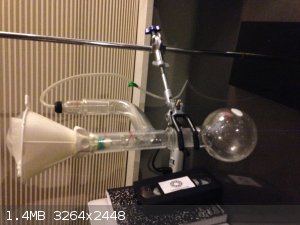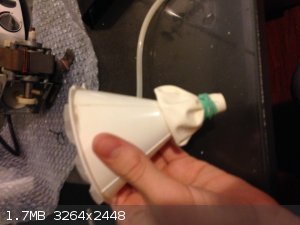Abromination
Hazard to Others
  
Posts: 432
Registered: 10-7-2018
Location: Alaska
Member Is Offline
Mood: 1,4 tar
|
|
DIY Vacuum Filtration
In about 3 minutes I built myself a cheap-ass buchner funnel, something that otherwise would cost me about 50 dollars. I stuck a balloon on the end of
a plastic funnel, pulled it up and held it down with rubber bands and found it fits perfectly into my 24/40 ground glass joints. I dont have a vacuum
flask, so I improvised one witha round bottomed flask, claison adaptor and
a still head thermometer adaptor. I just put in a coffee filter and pulled a vacuum, it works perfectly. I won't be pulling solvent fumes through my
pump, I don't trust it at all. I took it from a solder fume extractor for a cost of $0. I would highly recommend making a funnel like this for anyone
who can't afford the real thing.
 
EDIT: I am not liable for any injuries occuring to anyone who tries this. Understand I am using glassware built for vacuum and am using a very weak
pump.
[Edited on 25-12-18 by Abromination]
List of materials made by ScienceMadness.org users:
https://docs.google.com/spreadsheets/d/1nmJ8uq-h4IkXPxD5svnT...
--------------------------------
Elements Collected: H, Li, B, C, N, O, Mg, Al, Si, P, S, Fe, Ni, Cu, Zn, Ag, I, Au, Pb, Bi, Am
Last Acquired: B
Next: Na
-------------- |
|
|
ninhydric1
Hazard to Others
  
Posts: 345
Registered: 21-4-2017
Location: Western US
Member Is Offline
Mood: Bleached
|
|
Unless you know for sure that your distillation glassware can handle vacuum, I highly do not recommend doing this. If you use glassware as substitutes
for the thick-walled filtration glassware, you can risk the implosion of your substituted glassware, resulting in possible injury and loss of possibly
valuable filtrate. There are special filtration flasks/adapters for a reason; just a warning for those who want to try it.
I am no way attempting to attack you for your creativity; however, safety is always number one priority, and this setup is not safe compared to the
filtration setups that, while expensive, provide the safety needed toward the user while performing such tasks.
The philosophy of one century is the common sense of the next.
|
|
|
Abromination
Hazard to Others
  
Posts: 432
Registered: 10-7-2018
Location: Alaska
Member Is Offline
Mood: 1,4 tar
|
|
No need to worry, my glassware is specifically ment to be used under vacuum. I intended to use it for vacuum distillations apon its purchase,
although the need has not arisen. On the pump itself, it pulls an incredibly weak vacuum. It is hardly more then what a cheap vacuum cleaner would
produce, although I do appreciate your concern and will remember not to do this with my normal glassware.
List of materials made by ScienceMadness.org users:
https://docs.google.com/spreadsheets/d/1nmJ8uq-h4IkXPxD5svnT...
--------------------------------
Elements Collected: H, Li, B, C, N, O, Mg, Al, Si, P, S, Fe, Ni, Cu, Zn, Ag, I, Au, Pb, Bi, Am
Last Acquired: B
Next: Na
-------------- |
|
|
Sulaiman
International Hazard
    
Posts: 3698
Registered: 8-2-2015
Location: 3rd rock from the sun
Member Is Offline
|
|
Are you guys saying that my typical cheap Chinese glassware should not be used with a vacuum pump ?
I beleive that my side-arm conical flask for vacuum filtration using a Buchner funnel is made of thick glass because it is flat-bottomed for
stability,
I've so far considered RBFs, Claisen adapters etc. to be usable with any vacuum pressure/pump,
am I wrong ?
CAUTION : Hobby Chemist, not Professional or even Amateur
|
|
|
Abromination
Hazard to Others
  
Posts: 432
Registered: 10-7-2018
Location: Alaska
Member Is Offline
Mood: 1,4 tar
|
|
Quote: Originally posted by Sulaiman  | Are you guys saying that my typical cheap Chinese glassware should not be used with a vacuum pump ?
I beleive that my side-arm conical flask for vacuum filtration using a Buchner funnel is made of thick glass because it is flat-bottomed for
stability,
I've so far considered RBFs, Claisen adapters etc. to be usable with any vacuum pressure/pump,
am I wrong ? |
Honestly I agree with you and was simply assuring him that I wasnt going to get hurt.
It just happens that my only jointed glass is thick walled.
List of materials made by ScienceMadness.org users:
https://docs.google.com/spreadsheets/d/1nmJ8uq-h4IkXPxD5svnT...
--------------------------------
Elements Collected: H, Li, B, C, N, O, Mg, Al, Si, P, S, Fe, Ni, Cu, Zn, Ag, I, Au, Pb, Bi, Am
Last Acquired: B
Next: Na
-------------- |
|
|
morganbw
National Hazard
   
Posts: 561
Registered: 23-11-2014
Member Is Offline
Mood: No Mood
|
|
Quote: Originally posted by Sulaiman  | Are you guys saying that my typical cheap Chinese glassware should not be used with a vacuum pump ?
I beleive that my side-arm conical flask for vacuum filtration using a Buchner funnel is made of thick glass because it is flat-bottomed for
stability,
I've so far considered RBFs, Claisen adapters etc. to be usable with any vacuum pressure/pump,
am I wrong ? |
That is all that I have and do not worry about my glassware.
I do feel that common sense should be used and a careful inspection to make sure there are no little star cracks or anything that stands out.
I also think it would do no harm in having some sort of shielding between the glassware and self.
|
|
|
Dr.Bob
International Hazard
    
Posts: 2734
Registered: 26-1-2011
Location: USA - NC
Member Is Offline
Mood: No Mood
|
|
Most basic glassware can handle a vacuum, although flat bottom flasks are much less suitable than round ones. That is why filter flasks are so thick,
so that they can handle it better. But star cracks will weaken a flask a lot, so avoid those flasks for anything dangerous or under vacuum. And
larger items under vacuum produce much more stress/risk, due to surface area to volume issues, so shielding large vessels is wise.
And remember, the highest pressure differential you can get with a vacuum (on earth at least) is one atmosphere. so there is little difference
between a weak vacuum pump and a super strong vacuum, they both pull between 0.5 - 1.0 atmosphere of vacuum. Pressure is where you have to be much
more careful, as it is very easy to get pressures much more than 2 times normal in sealed glassware, so that is where being careful is much more of an
issue. I have used some HPLCs and other equipment that can generate 3000 psi or more, that can really hurt you, as can heating a sealed flask without
the proper equipment, controls, and shields.
|
|
|
beerwiz
Hazard to Others
  
Posts: 130
Registered: 6-2-2014
Member Is Offline
Mood: No Mood
|
|
I've had glassware implode on me before under vacuum. Luckily I had it wrapped in clear shipping tape and the implosion was no big deal, no glass flew
anywhere it all remained under the tape. I've never had RBF's implode on me, the glass that inploded on me was a flask with a flat bottom. Lesson
learned: never pull vacuum on a flat bottom RBF.
I love your idea but how do you prevent the filter paper from getting sucked into the flask? Maybe putting some mesh netting on the bottom will help
holding it in. Or some steel wool (brillo) in the hole.
|
|
|
|